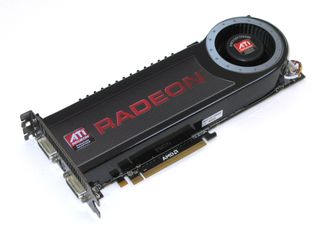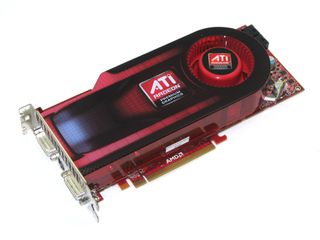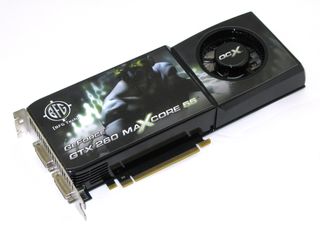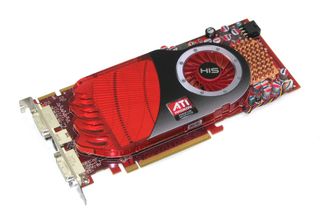Part 1: Building A Balanced Gaming PC
Graphics Cards

If you have any hope of playing the latest games in their full glory (by which we mean max'ed out details) and at high native LCD resolutions, we can’t overstate how important it is to have a powerful graphics card in your system. For our purposes here, we chose three cards from ATI and three cards from Nvidia, covering (at the time) a snapshot of the available gaming solutions priced $100 and up.
Naturally, a series of this magnitude takes weeks to plan for and test for; since we began, ATI has launched its Radeon HD 5000-series DirectX 11 boards. Thus, data for those cards won't be available in this part or the next. However, we're hoping to incorporate them into Parts 3 and 4.
Nevertheless, it's fairly easy to draw some parallels to our choices here, since ATI essentially doubled the resources on its previous single-GPU flagship. When you see a Radeon HD 4870 X2, imagine a Radeon HD 5870 there. The Radeon HD 4890 will generally be faster than the Radeon HD 5770. And the Radeon HD 5750 often looks a lot like the older Radeon HD 4770, if not a bit faster when you apply anti-aliasing.

BFG GeForce GTX 295
Representing the flagship of Nvidia’s GTX 200-series is the BFG GeForce GTX 295. Unlike the original GTX 295s, built on two PCBs, this newer revision features two GT200b GPUs on a single PCB.
Sporting a total of 1,792MB GDDR3 (896MB per GPU), two 448-bit memory interfaces, a 576 MHz core clock rate, a 1,242 MHz shader clock, and a 999 MHz memory clock, each GPU has the general specifications of Nvidia's GeForce GTX 260. However, the GPUs themselves boast a full 240 stream processing cores, like the GeForce GTX 285, GeForce GTX 280, and GeForce GTX 275.

ATI Radeon HD 4870 X2
Stay on the Cutting Edge
Join the experts who read Tom's Hardware for the inside track on enthusiast PC tech news — and have for over 25 years. We'll send breaking news and in-depth reviews of CPUs, GPUs, AI, maker hardware and more straight to your inbox.
The flagship of ATI’s Radeon HD 4800-series is still the Radeon HD 4870 X2, a card consisting of two Radeon HD 4870 GPUs. Each processor has its own dedicated 1GB GDDR5 (2GB total) frame buffer. The individual GPU specs are identical to a single-chip Radeon HD 4870, including 800 stream processors, 40 texture units, 16 ROPs (Raster Operation Units), a 256-bit memory bus, 750 MHz GPU, and 900 MHz memory frequency.

BFG GeForce GTX 285 OCFU
This BFG GeForce GTX 285 OCFU represents the most powerful single-GPU card available for our first round of testing. Its features include 240 shader processors, a 712 MHz core clock rate, a 1,620 MHz shader clock rate, 1GB of GDDR3 memory running at 1,332 MHz (2,664 MHz effective), and a 512-bit memory interface. These are extremely high (albeit overclocked) clock rates right out of the box, backed by BFG’s lifetime warranty.
For Part 1 and Part 2 testing, we down-clock this board to reference GeForce GTX 285 speeds of 648 MHz (core), 1,476 MHz (shader), and 1,242 MHz (memory).

ATI Radeon HD 4890
Representing ATI’s top single-GPU card from the 4800-series generation, the Radeon HD 4890 has the same vital GPU specifications listed above for the Radeon HD 4870 X2, like 1GB of GDDR5 memory, 800 shader processors, 40 texture units, 16 ROPs, and a 256-bit memory bus. However, the RV790 graphics processor made it possible for ATI to serve up higher clock rates (up to 850 MHz on the core and 975 MHz memory).

BFG GeForce GTX 260 OCX Max Core 55
The BFG GeForce GTX 260 OCX Max Core 55 combines 216 shader processors, 896MB of GDDR3 memory, BFG’s highest factory overclock on a GeForce GTX 260 of 655 MHz core, 1,404 shader, and 1,125 MHz on the memory clock (2,250 MHz effective). Of course, it's also covered by BFG’s lifetime warranty.
We again down-clock this board to reference speeds of 576 MHz core, 1,242 MHz shader, and 999 MHz memory frequencies for initial testing in Parts 1 and 2.

HIS Radeon HD 4850 512MB
The HIS Radeon HD 4850 has the same 800 ALUs, 40 texture units, and 16 ROPs as its bigger brothers, but it also has a lower GPU clock of 625MHz and 512MB of GDDR3 running at 993 MHz (1,986 MHz effective).
As a reminder: all testing for this first part was finished, but we couldn’t kick this series off prior to ATI’s Radeon HD 5800-series launch. To see how these new cards stack up to the ones used today, be sure to check out our launch reviews here and here.
Special thanks to ATI and Nvidia for arranging the graphics hardware needed to make this entire series possible.
-
yoy0yo Wow, this is an amazingly in depth review! I kinda feel that its sponsered by Asus or Corsair, but I guess you kept with the same brand for the sake of controls etc.Reply
Thankyou! -
inmytaxi Very helpful stuff.Reply
I'd like to see some discussion on the availability of sub $400 (at times as low as $280) 28" monitors. At this price range, does it make more sense to spend more on the LCD even if less is spent initially on graphics? I would think the benefit of 28" vs. 22" is so great that the extra money could be taken from, say, a 9550 + 4890 combo and getting a 8400/6300 + 4850 instead, with the right motherboard a second 4850 later will pass a 4890 anyway. -
frozenlead I like the balance charts. It's a good way to characterize the data. This article is well constructed and well thought-out.Reply
That being said - is there a way we can compile this data and compute an "optimized" system for the given hardware available? Finding the true, calculated sweet spot for performance/$ would be so nice to have on hand every quarter or twice a year. I'll have to think about this one for a while. There may be some concessions to make, and it might not even work out. But it would be so cool. -
Neggers I feel like the person that did this review got it finished alittle bit late. I can only assume he did all the testing some months back and has only just finished writing up his results. But its sad to not see the new P55/i5 Systems, AMD Athlon II Quad Cores, or the Radeon 5000 series.Reply
Good review, but hopefully it can be updated soon with some of the newer equipment thats out, to turn it into a fantastic guide for people. -
brockh Great job, this is the information people need to be seeing; the way people provide benchmarks these days hardly tells the story to most of the readers. It's definitely important to point out the disparities in ones CPU choice, rather than just assuming everyone uses the i7 all the sites choose. ;)Reply
Looking forward to part 2. -
Onyx2291 This will take up some of my time. Even though I know how, it's nice to get a refresher every now and then.Reply -
mohsh86 you are really kidding me by not considering the ATI 5000 series, although am a fan of nvidia , but this is not fair !Reply
Most Popular

